The Dodgers officially placed Charlie Haeger on the disabled list with right plantar fascitis — the move was announced in their daily press notes — allowing the team to recall John Ely to start Tuesday at Arizona.
Month: May 2010 (Page 5 of 6)
Clayton Kershaw’s 30th pitch of the first inning Sunday was a laser that on first glance looked too high and too inside to prevent him from walking in a run and unleashing another torrent of dread for the Dodgers. But home plate umpire Bruce Dreckman called it a strike, and on replay it appeared it was the right call.
Another right call: Having faith in Kershaw, who went from the tightrope to the autobahn in the Dodgers’ 2-0 victory over Colorado and Ubaldo Jimenez.
After loading the bases in the first on a single and two walks, Kershaw allowed only two more baserunners in his next seven scoreless innings, striking out nine. The Rockies didn’t once hit the ball to the outfield, as Eric Stephen of True Blue L.A. notes, until an eighth-inning flyout by Clint Barmes. Kershaw didn’t get first-pitch strikes on about half the batters he faced, but Colorado still couldn’t figure him out.
Kershaw’s shutout ball enabled the Dodgers to outlast Jimenez, who had thrown 104 pitches through seven innings and presumably could have continued if he hadn’t been pinch-hit for with one out in the top of the eighth. Russell Martin took advantage of the Rockies’ move to reliever Matt Daley with a hard home run to left. That run provided some comfort when a 50-foot single by Ryan Spilborghs in the ninth inning put runners on first and second against Jonathan Broxton. Ian Stewart swung at the next pitch, a fastball clocked at 95, but got under it, leaving Andre Ethier to stock the can of corn on the shelf and let the Dodgers come home victorious.
Ethier, of all people, struck out in all three of his at-bats against Jimenez, but the Dodgers for once won without his contributions.
The Dodgers’ first run of the game was brought home by Blake DeWitt, who had his sixth double in his past 12 games after having no extra-base hits in his first 14 games.
Tony Jackson of ESPNLosAngeles.com has more on the game.
* * *
Wild one in Albuquerque on Sunday. James McDonald started and allowed two runs over his first six innings, striking out six, then was pulled after allowing a walk and two singles to start the seventh. Jon Link relieved and allowed one inherited run to score while being charged with five others. The Isotopes still won, 15-12, thanks in part to a 4-for-4 (plus a walk) day from Chin-Lung Hu and a triple and homer from Jamie Hoffmann. Hu’s OPS crossed the .600 threshold and now sits at .618.
It is widely expected that John Ely will be recalled from Albuquerque to start Tuesday’s game. After being sent down Friday, the Dodgers needed to place a pitcher on the disabled list to allow Ely’s recall inside of 10 days. Sunday, the Dodgers began making a public case that Charlie Haeger has right heel problems. You do the math.

AP
Ubaldo Jimenez and Clayton Kershaw face off at Dodger Stadium today.
Colorado’s starting pitcher today is an ace. He’s 6-0 with an 0.87 ERA and 44 strikeouts in 41 1/13 innings against 43 baserunners.
But the Rockies didn’t trade for Ubaldo Jimenez. Jimenez came up through the Colorado farm system. He showed promise in half a season at age 23, was solid at age 24, excellent at age 25 and now, except for complete games, is putting up Fernando Valenzuela-like numbers at age 26.
Here are the stats for Jimenez and Dodger starters Clayton Kershaw and Chad Billingsley at last year’s All-Star break:
| Pitcher | Innings per start | ERA | BR/9 | K/9 |
|---|---|---|---|---|
| Jimenez | 6.4 | 3.81 | 12.3 | 7.9 |
| Kershaw | 5.5 | 3.16 | 11.6 | 8.9 |
| Billingsley | 6.6 | 3.38 | 11.5 | 8.5 |
Even allowing for the fact that Jimenez pitches half his games at Coors Field, could anyone have reasonably concluded that 10 months later, he would have an ERA more than 4.00 lower than Kershaw and Billingsley? That Billingsley wouldn’t be every bit as good as Jimenez or better, or that Kershaw wouldn’t be right on their tails?
While I understand – really, I do – why it’s expected that the Dodgers should use their resources to acquire more talent than their division rivals, right now the main difference between the front of the Colorado and Los Angeles starting rotations has nothing to do with that. The difference is that the 22-year-old Kershaw is still getting on track and the 25-year-old Billingsley got sidetracked, while at age 26, Jimenez has moved onto the fast track.
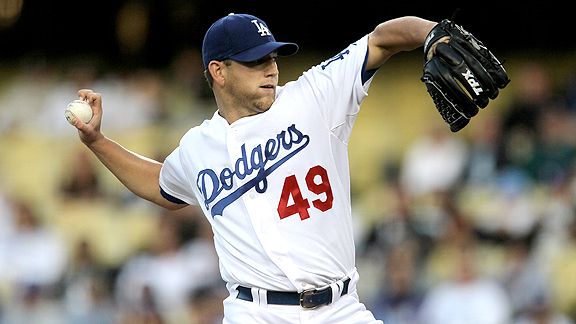
Stephen Dunn/Getty Images
Charlie Haeger couldn’t fool anyone tonight with his knuckler.
There’s the kind of gruesome that is Joe Theismann’s leg getting crushed beneath him by Lawrence Taylor, and then there’s the kind of gruesome that was the probable end of Charlie Haeger’s Dodger career.
Haeger nearly had more runs allowed (five) than strikes (eight) in his five-batter, no-out start tonight for the Dodgers, who lost, 8-0. The knuckleballer has given up 49 baserunners in 23 1/3 innings for the year with an 8.49 ERA. Even by the sorry standards of the Dodgers’ 2010 pitching, that’s some gangrene that is going to have to be amputated from the staff.
Ramon Ortiz, Carlos Monaserios, George Sherrill and Jeff Weaver combined for nine innings of three-run relief to keep the game from becoming one for the books, but in doing so left the Dodgers with a need for a Tuesday starting pitcher. John Ely can’t be called up that quickly unless a pitcher goes on the disabled list. The other options are pulling someone from the Albuquerque rotation – James McDonald (3.97 ERA), Scott Elbert (7.77 ERA) or Josh Lindblom (5.40 ERA) are currently scheduled for Sunday, Monday and Tuesday – and saving him the upcoming start at Arizona.
Jhoulys Chacin held the Dodgers without a run for 7 1/3 innings and was only really bothered by Andre Ethier, who had three of the six hits Chacin allowed. Ethier raised his batting average to .394 and his on-base percentage to .457. Chacin has now pitched 15 1/3 scoreless innings to start his season.
Manny Ramirez went 1 for 4 in his first game off the disabled list and ran down the line and in the outfield without trouble.
Shawn Hillegas, the last Dodger starting pitcher to fail to record an out (August 8, 1988), made his major-league debut 365 days earlier and came within one inning of a shutout. It’s a game of extremes.

Lisa Blumenfeld/Getty Images
Tonight will be Manny Ramirez’s 12th start in 30 Dodger games this season.
Tonight’s the first time we’re taking our family of five to a night game. Taking bets on who lasts longer: my 2-year-old or Charlie Haeger.
* * *
Mike Piazza hopes there’s a Mets cap on his Hall of Fame plaque, according to Joe Brescia of the New York Times (via Vin Scully Is My Homeboy).
- Tony Jackson of ESPNLosAngeles.com recaps the Dodgers’ 6-5 victory over Colorado on Friday.
- Friday was a day for the ages: 47-year-old Jamie Moyer becoming the oldest pitcher to throw a complete-game shutout, and 20-year-old Starlin Castro (baseball’s first player born in the 1990s) setting the record for most RBI in a major-league debut. (By the way, check out Satchel Paige’s 12-inning shutout at age 46.)
- Fifty years ago today, “quiet-mannered, pleasant gentleman of 32” Vin Scully had this interview in the Times (via Keith Thursby of the Daily Mirror). You might find some anecdotes there you haven’t heard before.
The Dodgers were due to make a roster move before tonight’s game to make room for Jeff Weaver coming off the disabled list, but it was not available when I was heading off to the magic show at my kids’ school. (The announcement was coming after batting practice.) So you’ll have to wait a little longer to find out who magically disappears from the team.
In the meantime, a couple of comments from Dodger manager Joe Torre to reporters:
On Xavier Paul: “He has a certain attitude about the way he plays the game. He’s pretty cool at the plate, he doesn’t get too excited and had a big two-strike hit last night. He is doing better in the field.”
On Charlie Haeger: “I’d like to see what I saw the other night: He needs to be around the plate with the knuckleball. He said he needs to just go out there and pitch, and has been over complicating things for himself.”
* * *
Frank McCourt has been ordered to pay Jamie McCourt $637,000 per month in spousal support, retroactive to December, reports The Associated Press. The McCourts have also been told to sell their $7 million home in Cabo San Lucas and split the proceeds to help cover their legal fees, according to TMZ. Joshua Fisher of Dodger Divorce has more:
The biggest damage to Frank coming out of today’s news is that Commissioner Gordon didn’t buy Frank’s neat little attempt to have the court bless the post-nup. Frank, you’ll recall, wanted the court to order Jamie to dispose of some of the couple’s real estate to help pay her bills. Such an order would have implicitly acknowledged the validity of the post-nup, which stipulates that the residential properties are Jamie’s and the Dodgers Frank’s in the case of a divorce.
If it makes you feel any better, it’s not like that money would have gone into the team had the McCourts stuck together.
* * *
Earlier this week, Tom Hoffarth of the Daily News reflected on how Ernie Harwell might have come to Los Angeles with the Dodgers and Vin Scully could have ended up the Giants’ play-by-play man.
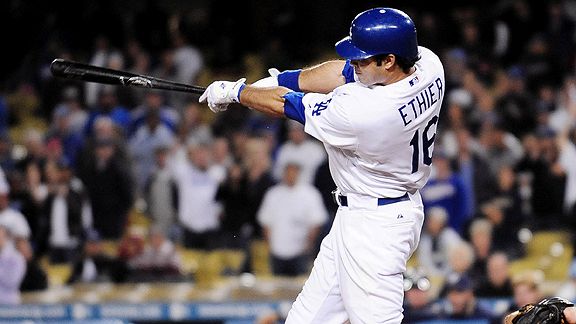
Gary A. Vasquez/US Presswire
Andre Ethier connects for his walkoff grand slam Thursday.
Andre Ethier’s walking off right into the stuff of legend, the kind of thing people will remember decades from now, the kind of thing you want to appreciate even when times aren’t great.
Ethier has converted 25 percent of his 44 walkoff opportunities, the highest percentage in baseball since 2006 (minumum 20 opportunities), according to David Pinto of Baseball Musings.
By comparison, Pinto writes, Adrian Gonzalez of San Diego has had 59 walkoff opportunities in that time and converted two, and Florida’s Hanley Ramirez is 0 for 50.
Stat of the Day notes that Ethier’s 11 walkoff hits since 2008 are twice as many as anyone else in baseball. Five of Ethier’s past six have been homers.
Ethier remains a Triple Crown contender in the early going, tied for the National League lead in homers and tops in RBI, but despite what has been written elsewhere, he still doesn’t lead the league in batting average. Washington’s Ivan Rodriguez is 31 for 77 (.403) with 84 total plate appearances. Washington has played 28 games, so he needs 87 PA to qualify for the league lead. If you give him three more outs, as the rules would dictate at the end of the season, Rodriguez would be 31 for 80 – .388 – ahead of Ethier’s .377. Ethier still leads the NL in slugging percentage and OPS.
By the way, what is Ivan Rodriguez doing leading the NL in batting average?
* * *
Quote of the mornin’ comes from Ken Gurnick of MLB.com, in the wake of key contributions by John Ely and Xavier Paul in Thursday’s victory: “Maybe instead of sending more rookies down, the Dodgers should be calling more of them up.”
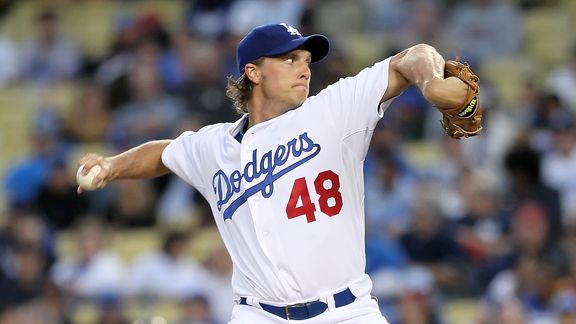
Jeff Gross/Getty Images
John Ely
With a near-perfect changeup offsetting a fastball that sat in the high 80s, John Ely simply dazzled in his second major-league start, which the Dodgers won, 7-3.*
For the first six innings, Ely, who turns 24 in a week, put the fun in efficiency, requiring only 80 pitches to shut out Milwaukee on two singles and no walks while striking out seven. He retired 16 batters in a row after allowing a second-inning hit to Casey McGehee. His only three-ball counts in the first six innings came against Jim Edmonds, who struck out each time (and one other).
The Brewers pecked away at Ely in the seventh, fouling off 11 of his 28 pitches to scratch across their only run. It remains to be seen whether Ely can survive with that fastball, but if he can keep pairing it up with that change while attacking the strike zone, there’s potential. And if nothing else, he was a sight for sore eyes and arms tonight.
The Dodgers earlier indicated that Ely would head back to the minor leagues after today’s performance to make room for Jeff Weaver coming off the disabled list, but it’s almost unfathomable that the team would do so with its starting pitching in the disarray it has been in. Keeping Ely would require the Dodgers to shed Ramon Ortiz – if somehow the Dodgers can’t wrap their head around letting him go, then Ely will rejoin Albuquerque inside of 24 hours.
I’m looking at that last paragraph again. Keeping a 24-year-old pitcher with a plus changeup who threw six shutout innings would require the Dodgers to let go of 37-year-old Ramon Ortiz. This is kind of like the $100 question on “Who Wants to Be a Millionaire?”
*Footnote: The Dodgers won after Jonathan Broxton blew the save on a walkoff grand slam by Andre Ethier in the bottom of the ninth.
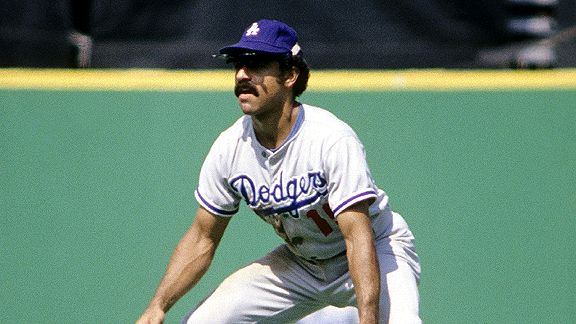
Focus on Sport/Getty Images
Second baseman Davey Lopes hit 28 homers in 1979 and stole 44 bases (in 48 attempts), all for a team that lost 83 games.
More stark stats: No Los Angeles Dodger team that started the season 11-16 or worse after 27 games has finished above .500, notes Eric Stephen of True Blue L.A. That got me thinking about the Dodgers’ 1979 team again.
From Dodger Thoughts, February 1 (my first day at ESPN):
The year after the Dodgers lost two consecutive World Series in 1977-78, they were in last place at the All-Star break. …
The 1979 Dodgers, who seemed to have everything going for them entering the season except the departure of Tommy John, lost 31 of 41 games leading into the All-Star Game, digging themselves a hole so deep that not even a league-leading 43 victories after the break could save them. …
If the Dodgers falter (in 2010), it will undoubtedly be seen through the prism of the McCourts’ divorce, with everyone pointing out how the Dodgers didn’t get the reinforcements they needed. But not getting enough reinforcements is a historical pattern for the Dodgers. No Dodger team, in Brooklyn or Los Angeles, has ever made the postseason three years in a row. None. The 2010 Dodgers have a chance to be the first (not to mention a chance to be the first to win a World Series in 22 years). Their season will ride a thin line between ecstasy and disappointment.
There probably aren’t any Dodger followers, including myself, that don’t wish the team had more talent entering the 2010 season, that don’t wonder if an opportunity to get over the top is being squandered. You always want your odds to be the best they can be. But they never are.

Getty Images
Stat o’ the Day: Just 27 games into the Dodgers’ 2010 season, Ramon Troncoso has already pitched in 11 losses.
It may be early, but the fans are going wild – and not in a good way.
Wednesday’s 11-3 loss to Milwaukee marked the one-month anniversary of a Dodger season that began with an 11-5 loss to Pittsburgh. Two days shy of one year since Manny Ramirez’s suspension, it’s remarkable to think back and realize: The Dodger community was probably in better spirits that sorry day than now.
The wreckage of the Dodgers’ start to 2010 fits perfectly with the narrative that began in the offseason, which foretold that the divorce of Frank and Jamie McCourt would have a domino effect that would leave the franchise in ruins. And while this isn’t exactly Carthage, it is last place in the National League West in May.
A different ownership situation might have bred a different start to the season, it’s true. No, a pair of happily married McCourts would not have turned the 2009-10 Dodger offseason into a wheeling-and-dealing free-for-all – not after reaching the National League Championship Series two straight years, certainly not after the Jason Schmidt and Andruw Jones debacles of recent offseasons. But Frank and Jamie surely wouldn’t have made fewer moves if they were still going steady.
But what’s sad about the 2010 Dodgers is that the doleful divorce has been only one of many, many, many other things that have gone wrong this season. Here begins “Lament: Why Even in Their Worst Nightmares, the Dodgers Couldn’t Fathom Being This Bad.”
Chapter the First: A Rotation Off Its Axis

Mixed bag: The last 23 batters Chad Billingsley faced Wednesday did not score; the first four did.
Consider, if you will, that the Dodger starting rotation at the end of the 2009 season was made up of Randy Wolf (having something of a career year), a wounded Hiroki Kuroda, a staggering Chad Billingsley, a green Clayton Kershaw, and Vicente Padilla having, well, two great weeks.
Though spring training 2010 began with Wolf in a Milwaukee Brewers uniform, there was every reason to believe that at least 60 percent of that bunch would be better than they were – in contrast to Wolf, who you’d reasonably expect to decline after everything imaginable went right for him at age 33. And in fact, that’s exactly what happened with Kuroda, who has a 2.08 ERA while averaging 6.9 innings per start this year.
But though they have had their moments, Billingsley and Kershaw haven’t exactly been the equivalent of, say, Colorado’s Ubaldo Jimenez, who has pitched 41 1/3 innings with a 0.87 ERA and 44 strikeouts. The growing pains are still evident – more painfully in the case of Billingsley, who is only six months younger than the cherry-picked Jimenez, but more fable-busting for Kershaw, who was supposed to be the guy with the head on his shoulders but instead has walked a mind-boggling seven batters per nine innings in ’09. Both still have bright futures, but the need for more consistency remains. (Tony Jackson of ESPNLosAngeles has more on Billingsley.)
Then there was Padilla, who had two fine starts in the postseason but otherwise had been a forgettable pitcher for most of the past five years or more. The Dodgers chose him in January over Jon Garland, a pitcher they thought enough of five months earlier that they traded infield prospect Tony Abreu for him. The 30-year-old Garland, who signed with San Diego for a guaranteed $5.9 million (including a potential 2011 $600,000 club buyout), has an ERA of 2.06 (adjusted ERA 184) over 35 innings in six starts. The 32-year-old Padilla, who signed with the Dodgers for a guaranteed $5.025 million plus incentives, has pulled a mini-Schmidt: 21 2/3 innings, 6.65 ERA (61 ERA+) and an indefinite stay on the disabled list. This wasn’t the divorce or the budget talking. The Dodgers made a pretty simple either-or choice, and at least to this point, they chose wrong. (And did so even with the character issues that are supposedly so important to Dodger general manager Ned Colletti being in Garland’s favor.)
The fifth spot in the Dodger starting rotation had a number of candidates, though ideally there should only have been two: James McDonald and Scott Elbert. McDonald was the 2008 and 2009 Dodger Minor League Pitcher of the Year who had a rough start in 2010 before finishing the year strong. Elbert is considered by many to be an even brighter prospect. However, neither came close to making any kind of case in spring training that they belonged in the rotation – though they were given little opportunity while manager Joe Torre quickly turned his focus to pitchers who had no more minor-league options, like perennial also-ran Eric Stults and knuckleballer Charlie Haeger, along with a cascade of scrapheap veterans like the Ortiz Unbrothers, Ramon and Russ. Honestly, it was reasonable to suspect that someone from McDonald, Elbert and frenemies could give the Dodgers inconsistent but useful enough output in the back of the rotation – and the Dodgers have certainly had their share of luck in this area in recent years – but it hasn’t come close to happening. That in turn made the Dodgers particularly ill-prepared, at least at this point, for an injury to one of their front four starters, even Padilla.
This brings us back to the four pitchers most talked about this Dodger offseason. One was Wolf, who had a 4.91 ERA after three starts this season but has since allowed two runs in his past 14 innings. Two was John Lackey, who signed a five-year, $82 million contract with the Red Sox and has a 3.89 ERA. Lackey figured to be a B version of the former Dodger with the famous seven-year contract itch, Kevin Brown – not quite as expensive but not quite as good and arguably every bit as likely to get injured for part of his contract. Lackey raises a good question: Do you pay big money for a pitcher even knowing that one of those years he’s likely to spend on the DL? I would have said no – and perhaps that’s ultimately a question for the accountants – but given the Dodgers’ current pitching desperation, many people would probably be inclined to say yes.
Pitchers three and four are Cliff Lee and Roy Halladay, the most-discussed trade targets of the past year. Whatever efforts the Dodgers made to acquire them, the organization has ultimately had to bet that what they had in Kershaw and Billingsley (among other young players) in the long term would be worth more than what they would get out of Lee and Halladay in the short term – not a bad bet, but strictly as of May 2010, a losing bet.
So there you have it. We’ve discussed close to a dozen starting pitchers, and of that group, only Kuroda has given the Dodgers a happy beginning to 2010. Some of the misfortune the Dodgers brought upon themselves; some of it has been ill-fated – but when you add it all up, it’s almost a clean sweep for Murphy’s Law over Los Angeles.
Chapter the Second: The Blahpen
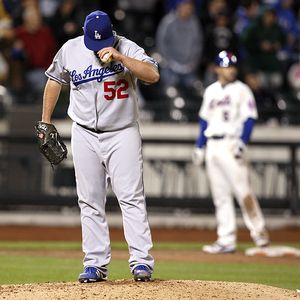
George Sherrill: 0.65 ERA as a Dodger in 2009, 9.00 in 2010.
When your best reliever (Jonathan Broxton) hasn’t even pitched nine innings all year, when your next-best bullpen success story is a Rule 5 draftee (Carlos Monasterios) who remains on the roster, things have gone horribly wrong.
Maybe it all started with Ronald Belisario, for virtually all of spring training trapped in a distant land like a passenger crashing with Oceanic 815, his absence shifting the balance of the bullpen when the season began ever-so-slightly yet ever-so-significantly. His MIA act, accompanied by another ill-timed injury to lefty mesmerizer Hong-Chih Kuo and an almost complete reversal-of-fortune by 2009’s stellar set-up man, George Sherrill, turned a key Dodger strength into a disaster area. In the Dodgers’ first 15 games of 2010, the bullpen lost five – that alone made a huge difference between the Dodgers being 11-16 this morning as opposed to 16-11, of being 5 1/2 games out of first place as opposed to just half a game. And that doesn’t even count games like Wednesday’s, in which the bullpen was handed a one-run deficit and let it multiply by 800%.
What did the Dodgers do wrong with their relievers? Not a lot. Yeah, if money were no object, they could have outbid the Angels for a guy like Fernando Rodney, who signed for an exorbitant amount of money for a reliever: two years, $11 million. Or they could have spent $50,000 on a chaperone for Belisario. Beyond that, what they assembled was battle-tested and looked like one of the best bullpens in baseball. It just hasn’t worked out that way.
Chapter the Third: Defenestrate the defense
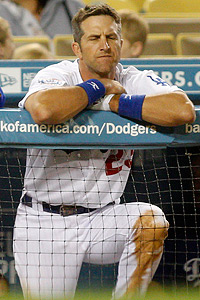
Charged with 10 errors last year, Casey Blake has made half that many this year.
Wednesday, Major League Baseball announced that a change by the official scorer gave James Loney a throwing error for a play that occurred against the Reds nearly two weeks before. It kind of fit: The Dodger defense has been so poor this year that it can pick up errors without even playing.
The defense had actually been on a modest streak of errorless games recently until Wednesday night against the Brewers, when Casey Blake threw in the dirt in the seventh inning of what at the time was a one-run game. Before the night was over, the team botched a rundown play and Blake made another error, his fifth in 24 games.
It felt very familiar. For most of the year, the defense has been toxic. The expected weak spots, such as Ramirez in left field, haven’t even been the story. There have been mistakes all over the field, to the extent that Matt Kemp’s 2009 Gold Glove in center field is being examined for “Dewey Defeats Truman” inaccuracies.
The defense broke the levee on the already cracking Dodger pitching, helping spoil what really was a true onslaught by the Dodger offense in the opening days of the year. The Dodgers averaged 6.5 runs in those first 15 games, but lost eight of them. And yet at seven of eight positions, this was the same defense that the Dodgers took to the NL playoffs last year. The mere aging of players Blake and Ramirez doesn’t begin to explain it. Did the Dodgers not prepare properly in spring training? Who knows? But this was another walk off the cliff that at least in part appeared out of nowhere.
Chapter the Fourth: Yes, Everyone Gets Injuries …
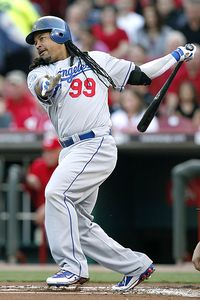
Manny Ramirez has a 1.159 OPS – but only 52 plate appearances.
… so we won’t cry too long over the Dodgers’ sick bay. Losing Kuo was one thing, losing Jeff Weaver was barely anything, but losing Padilla was a problematic thing, and then Ramirez and Rafael Furcal going out almost simultaneously was a big thing. No one expected either Ramirez or Furcal to play 162 games, but in a better Dodger world, they would have at least made it through April. Heck, Ramirez made it into May last year before he was unceremoniously sidelined by what turned up in the lab.
In any case, it’s fair to say that the Dodgers knew in advance they would need a bench this year – and it’s no secret that Colletti has always liked to have depth. But again, some choices that had nothing to do with the divorce have gone awry. For example, on December 16, Jamey Carroll (36 in February) signed with the Dodgers for nearly $4 million over two years. Two weeks later, Kelly Johnson (28 in February) signed a cheaper contract in overall value with Arizona: one year, $2.35 million. Carroll has a .383 on-base percentage but just one extra-base hit. Johnson was just named NL Player of the Month after going 25 for 80 with eight doubles and nine home runs – a .404 on-base percentage and .750 slugging percentage.
Brad Ausmus and Garret Anderson have been wasted signings, albeit relatively inexpensive ones. You’re never going to get ’em all right, and you can certainly argue that so far, Ronnie Belliard has been worth the $825,000 he lost weight to earn from the Dodgers, while Reed Johnson has been what you’d expect him to be. But those are the few breaks the Dodgers have caught, in a first month that exposed another nagging worry sooner than they would have hoped.
Chapter the Fifth: Five months to go
Wednesday, Billingsley gave up four runs in the first inning – then pitched five shutout innings and could have come out battling for a win in the seventh inning had Carroll, well, been able to hit his first three-run homer in 2,574 career plate appearances. Yep, this is when you bring out the unseemly disclaimer: It’s still early.
I haven’t even wanted to mention that the 2009 Colorado Rockies started with an 11-16 record at this time last year, exactly where the Dodgers are today – and then lost 12 of their next 19 before bouncing back with a months-long hot streak that scared the pajamas off every NL rival going into the playoffs. When John Ely, who was something like the Dodgers’ No. 14 starter entering spring training, is the guy you’re counting on for the second week in a row to prevent a series sweep, it’s not auspicious. If Kuroda goes down at some point this year, the Dodgers could give their 91-loss 2005 a run for its worthless money. But yes, it’s still early.
Maybe with happier owners, the Dodgers sign Wolf. Mainly with different owners, the Dodgers splurge for Lackey. Maybe there’s a parallel universe where the Dodgers make the big trade for Lee or convince Halladay that the West Coast ain’t so bad. But the Dodger problems in 2010 have been much more than the loss of one veteran pitcher.
And that’s with some things that people expected to go wrong not doing so at all. Kuroda wasn’t done as a pitcher. Ramirez wasn’t done as a hitter. Broxton has not been scarred by Jimmy Rollins’ game-winning double in the 2009 NLCS. Andre Ethier hasn’t regressed – he’s an early contender for the Triple Crown. James Loney is showing signs of life.
For that matter, Juan Pierre, the supposedly reborn savior from 2009 who was sent to the White Sox for 2010, is batting .226, with seven walks and 15 steals in 19 attempts but no extra-base hits.
It’s still early – but whether it’s early enough for a turnaround or just early in a miserable year, I don’t know. Even for a team playing ball both on the field and in divorce court, so much can change between May and October. After all, look at what’s happened to the Dodgers between October and May.
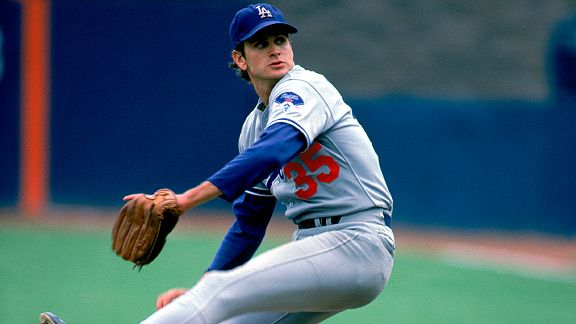
Getty Images
The Dodgers traded 31-year-old Bob Welch (pictured above in 1983) after a 1987 season in which he had a 3.22 ERA and 196 strikeouts in 251 2/3 innings.
Former Dodger general manager Fred Claire was interviewed at length by Albert Lyu of FullCountPitch.com about how the 1988 World Series championship Dodgers were constructed. It’s a good read – including news that the Dodgers had seriously contemplated a Pedro Guerrero-for-Kirk Gibson trade before Gibson became a free agent.
I can’t help wondering what the reaction would have been on Dodger Thoughts to the news that Bob Welch and two relievers had been sent away for Alfredo Griffin, Jay Howell and Jesse Orosco.
- Joe Torre told reporters today Charlie Haeger would start for the Dodgers on Saturday. Carlos Monasterios is in the bullpen for now. When Jeff Weaver is activated, John Ely might be optioned to the minors no matter how well he does in his start Thursday.
- Torre said that Manny Ramirez would be activated from the disabled list Saturday.
- Doug Mientkiewicz signed a minor-league contract with Florida, according to Matt Eddy of Baseball America.
- If you have a 3D TV and subscribe to DirecTV, your first chance to see a live major-league game in 3D at home is now looking like the Yankees at Mariners on July 10, according to Stuart Levine of Variety.
- Ernie Harwell’s passing Tuesday means this is a good time to see, if you haven’t, Elizabeth Merrill’s ESPN.com piece on Harwell saying goodbye.
The last time Clayton Kershaw started but failed to get past the third inning – June 10, 2009 – this is what happened the rest of the season: 107 innings, 122 baserunners, 123 strikeouts, 1.77 ERA.
Update: I’ll be doing a live chat at Variety talking all things TV at 11:30 a.m. today. Come on over …
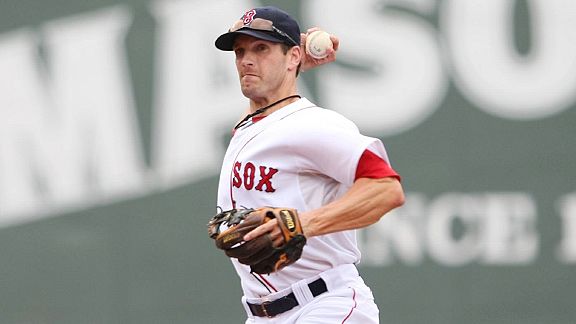
Elsa/Getty Images
New Dodger backup infielder Nick Green had an .804 OPS last year with Boston through June 21, then a .494 after.
Bob Timmermann has a great interview with Josh Wilker of Cardboard Gods about his new book at Native Intelligence.
Blue Heaven passes along a great overhead shot of the Dodgers’ 1942 Spring Training site in Daytona Beach, Florida.
The legendary Ernie Harwell, the former Dodger and longtime Tiger broadcaster, passed away today at age 92. He was scheduled to be awarded the Vin Scully Lifetime Achievement Award in Sports Broadcasting by Fordham University on Wednesday.
We’ll miss you, Ernie.



